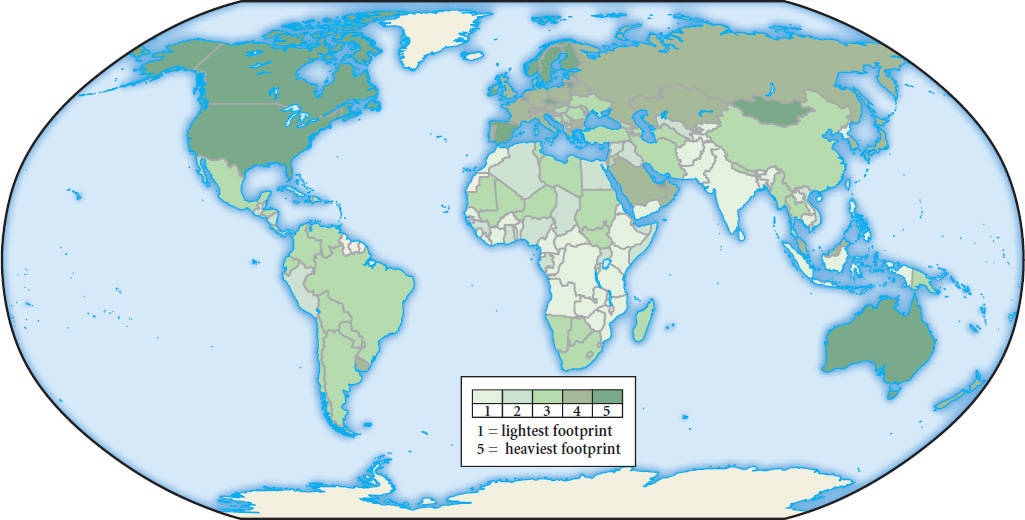The Global Environment Transformed
Change
Question
Cps2PtfGwh2tQtxUAMph+unKk+wsxoL/Mu+YH3Yj5Espugczb39d1UUnlYuVqsStri9mhna0t3JTEMgnTVkiFu4YpiJwQ6BFY/UFoa5o7SlKWEYgDeMSaKnTy1uhllMJGuyy58AKYrBSbZUDigkCadJR+s2Hktx2lWI0EQ==[Answer Question]
Underlying the environmental changes of the twentieth century were three factors that vastly magnified the human impact on earth’s ecological systems far beyond anything previously known.24 One was the explosion of human numbers, an unprecedented quadrupling of the world’s population in a single century, leaving the world of 2012 with over 7 billion people compared to about 1.6 billion in 1900. It was a demographic revolution born of medical and sanitation advances that dramatically lowered death rates and Green Revolution technologies such as genetically modified seeds and fertilizers that substantially increased world food supplies. A second cause of environmental stress lay in the amazing new ability of humankind to tap the energy potential of fossil fuels—coal in the nineteenth century and oil in the twentieth. Hydroelectricity, natural gas, and nuclear power added to the energy resources available to our species. These new sources of energy made possible a third contribution to environmental transformation—phenomenal economic growth—as modern science and technology immensely increased the production of goods and services. Between the 1890s and the 1990s, global industrial output grew by a factor of 40, although very unevenly across the planet. An average North American in the 1990s, for example, used 50 to 100 times more energy than an average Bangladeshi (see Map 23.4). But almost everywhere—in capitalist, communist, and developing countries alike—the idea of economic growth or “development” as something possible and desirable took hold as a novel element of global culture.

These three factors were the foundations for the immense environmental transformations of the twentieth century. Human activity had always altered the natural order, usually on a local basis, but now the scale of that impact assumed global and perhaps even geological proportions. The growing numbers of the poor and the growing consumption of the rich led to the doubling of cropland, a corresponding contraction of the world’s forests and grasslands, and dramatic increases in the rate of erosion. Huge urban complexes have transformed the landscape in many places. With diminished habitats, numerous species of plants and animals either disappeared or were threatened with extinction at a rate many times greater than the background level. Certainly massive species extinctions have occurred much earlier in the history of the planet (the dinosaurs, for example), but this wave of extinctions is happening at the hands of humankind. The human remaking of the ecosystem has also greatly increased the presence of plants and animals that have benefited from human activity—cattle, pigs, chickens, rats, wheat, corn, and dandelions. By some estimates, 90 percent of all plant activity now occurs in environments shaped by human action.
The global spread of modern industry, heavily dependent on fossil fuels, created a pall of air pollution in many major cities. By the 1970s, traffic police in Tokyo frequently wore face masks. In Mexico City, officials estimated in 2002 that air pollution killed 35,000 people every year. Industrial pollution in the Soviet Union rendered about half of the country’s rivers severely polluted by the late 1980s, while fully 20 percent of its population lived in regions defined as “ecological disasters.” The release of chemicals known as chlorofluorocarbons thinned the ozone layer, which protects the earth from excessive ultraviolet radiation.
The most critical and intractable environmental transformation was global warming. By the end of the twentieth century, a worldwide scientific consensus had emerged that the vastly increased burning of fossil fuels, which emit heat-trapping greenhouse gases such as carbon dioxide, as well as the loss of trees that would otherwise remove it from the air, had begun to warm the atmosphere significantly. By 2010, carbon dioxide concentration in the atmosphere was about one-third higher than preindustrial levels. Although considerable disagreement existed about the rate and likely consequences of this process, indications of melting glaciers and polar ice caps, rising sea levels, thawing permafrost, extreme hurricanes, further species extinctions, and other ecological threats have punctuated global discussion of this issue. It was clearly a global phenomenon and, for many people, it demanded global action.